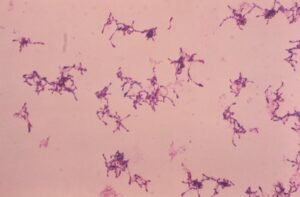Respiratory Syncytial Virus (Presentation)
Respiratory Syncytial Virus is a single-stranded RNA virus with a negative sense, non-segmental RNA. It is an enveloped virus with many proteins, which help perform various functions like Attachment to the host cell, the fusion of host cell membranes, ion channels, viral assembly, RNA binding, transcription, phosphorylation, immune evasion etc.

The virus may have a spherical or filamentous structure – it is pleomorphic.

RSV belongs to the mononegavirales order, paramyxoviridae family and Pneumovirinae subfamily. It is related to other common cold viruses, like human Metapneumovirus and Parainfluenzavirus.

RSV is among the commonest causes of respiratory illness in children, especially infants. The immunity conferred is partial; hence reinfection may occur. Infection in adults tends to be milder. However, certain risk groups could be affected by severe infection.
RSV infection is a disease of the winter. Peak is usually in December.

Certain groups of patients are at a higher risk of severe disease.

The transmission of RSV is mainly droplet mediated. The infectious droplets may travel approximately 1-2 metres and land on the mucous membrane of vulnerable people, subsequently infecting them.
Those particles that land on other surfaces may remain infective for up to 24 hours but could be much shorter depending on the surface. Anyone touching these surfaces may carry the virus to their nose/mouth, or eye to infect themselves (unless they wash their hands before touching their face).

After the virus comes in contact with the mucous membrane, it may take 3-5 days to develop the disease. All the people who are exposed may not develop the disease. In some cases, our immunity may clear the virus. Once a person is infected, they may remain infectious for approximately 3-5 days. Some groups of patients, like children, immunocompromised or those with severe diseases, may remain infectious much longer (up to 4-6 weeks).
Aerosol-generating procedures: certain medical procedures may generate smaller infective particles. In these cases, virus can be transmitted more than 1-2 metres, and a higher level of protection is required (respiratory protection)
RSV may affect:
Upper respiratory tract causing – rhinorrhoea, nasal congestion, sore throat, and cough.
Lower respiratory tract causing – tachypnoea, wheezing, shortness of breath, apnoea, hypoxia
Other symptoms – fever, malaise, difficulty feeding, otitis media.

The signs and symptoms take about 2-4 days to progress.
RSV start replicating in the nasopharynx, eventually affecting the bronchioles, causing bronchiolitis. The infection results in an inflammatory response – infiltration of the inflammatory cells, submucosal oedema, and necrosis of the epithelial cells. The thickening of the wall and increased mucous with debris reduces the bronchioles’ diameter and forms mucous (+debris) plugs.
This narrowing of the bronchus may cause wheeze, air trapping or collapse of the pulmonary alveolus.


Besides RSV, human metapneumovirus, parainfluenza virus 3 and flu are relatively common causes of bronchiolitis. Other respiratory viruses can also cause bronchiolitis. They also cause coinfection with RSV.

Diagnosis is clinical. It is not recommended to test for RSV routinely.
Direct fluorescent antibody testing and PCR can be used to test for RSV. Viral culture is the gold standard, but it is time-consuming, labour intensive and not readily available.

Treatment:
Treatment is mainly supportive.

Palivizumab
It is an RSV-specific humanized monoclonal antibody. Palivizumab is used to protect
against RSV in at-risk patients and has been shown to decrease hospitalisation in this group. It is part of a UK-wide immunisation schedule per guidance issued by the Joint Committee on Vaccination and Immunisation (JCVI) in 2010. The age group and specific recommendations can be found in the
- Greenbook Chapter 27a and
- PHE document ( https://www.england.nhs.uk/wp-content/uploads/2020/10/C1338-palivizumab-rps-update-june-2021.pdf )



